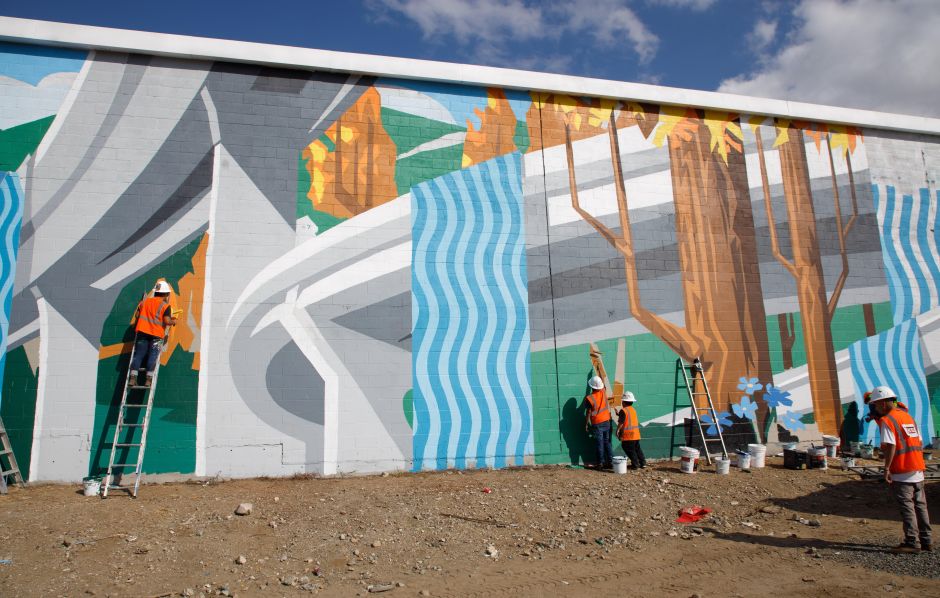‘Rushing Waters’ name that bears the mural also wants to give the Latin neighborhood a new image
A group of Latin artists who want to return to Los Angeles (California) the designation of American capital of the murals, unveiled this Monday a work of 10,000 square feet (929 square meters) in a Hispanic neighborhood that struggles to claim its image in the region .
The mural “Rushing Waters” (Aguas Caudalosas) became today the largest work in the north of the city, in an effort to claim urban art, which characterized Los Angeles in the 70s.
"It's a big change, not only for the people who live here, but it's going to change the impression of all of Los Angeles and the visitors that come to this neighborhood," said muralist Levi Ponce, in charge of the project.
Ponce, which for this project brought together more than 30 artists, highlights that it is the largest investment for street art in the city since 1978.
In the 70s, Los Angeles held the title of the capital of muralism in the United States, when the Chicano Movement had shaped its struggle on the walls of the important angel city.

The 32-year-old artist was born in Pacoima, a neighborhood in Los Angeles well known for this plastic manifestation of urban character.
Over time, Ponce has become one of the precursors of the renaissance of painting in murals, after abolishing, in 2013, a ban on such expressions and that lasted more than 10 years.
The task has not been easy, and it is that the mural that opened yesterday took more than five years to complete, since the idea of rescuing a wall located just outside Pacoima emerged, a neighborhood also with low economic resources and eminently Latin.
The biggest problem in carrying out the works, says Ponce, is the bureaucracy and the time it takes for permits.
"If the mural is something political or with a theme today, it is hard to do," he insists.
The muralist confesses that he has done a lot of street art without permission, in secret and at night. However, its new cause is to bring to light the talents of the city and remove the stigma of "illegality" in this way of expression.
"Rushing Waters" is the example of how a wall that was initially full of graffiti could become a unified message, which included artists working in the shadows and city officials.
The consensus was achieved after long conversations with the youth of the community.
"It is very beautiful and very special to see that two groups in the city are working on the same border and not fighting for a space," explains Ponce.
For the plastic creator José Javier López Cruz any community where there is violence, a mural like “Rushing Waters” sends a message that there is something positive happening.
“Sometimes people are afraid to get here, but now there are large, beautiful murals, which gives them confidence. It's another look from our community, ”Lopez added.
In that sense, his colleague Héctor “Tetris” Arias points out that murals also bring benefits to immigrant communities.
“A mural is an international language where everyone can appreciate it, it is universal, it is very powerful to have murals that represent all communities,” warns Arias, a native of Michoacán.
Evoking the water sources that characterized the region, "Rushing Waters" is also a tribute to the Tataviam tribe, the indigenous group that inhabited the region before the settlers arrived.
The large oaks that were once part of the landscape of the area, combined with multicolored flowers, seek to represent a historically low-income community, but with great treasures to show.
"They are (works) inspired by the same people of Pacoima, the people, the neighborhoods, and what we have here, which is not much but what we have we put it up," Ponce considers.
The artists hope that the work, which had the support of Councilwoman Monica Rodriguez, inspires other local officials in their commitment to street art, in order to return the capital designation of muralism that once had Los Angeles.
"It is in our hands, as artists from our community once did, we have to defend that heritage and create more spaces of expression for everyone," said Ponce.
Click on the star of Google News and follow us







